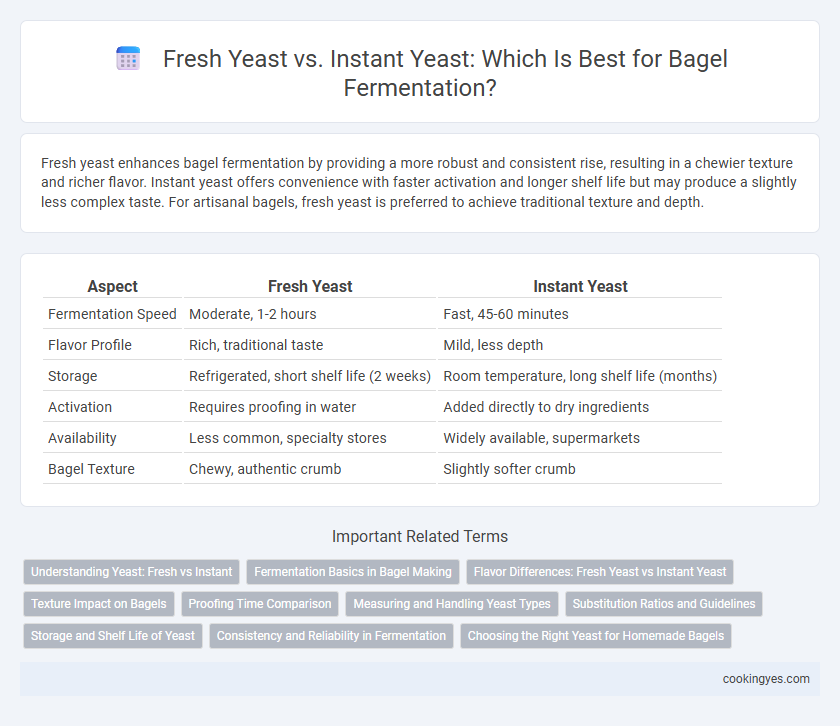Fresh yeast enhances bagel fermentation by providing a more robust and consistent rise, resulting in a chewier texture and richer flavor. Instant yeast offers convenience with faster activation and longer shelf life but may produce a slightly less complex taste. For artisanal bagels, fresh yeast is preferred to achieve traditional texture and depth.
Table of Comparison
| Aspect | Fresh Yeast | Instant Yeast |
|---|---|---|
| Fermentation Speed | Moderate, 1-2 hours | Fast, 45-60 minutes |
| Flavor Profile | Rich, traditional taste | Mild, less depth |
| Storage | Refrigerated, short shelf life (2 weeks) | Room temperature, long shelf life (months) |
| Activation | Requires proofing in water | Added directly to dry ingredients |
| Availability | Less common, specialty stores | Widely available, supermarkets |
| Bagel Texture | Chewy, authentic crumb | Slightly softer crumb |
Understanding Yeast: Fresh vs Instant
Fresh yeast contains live yeast cells with higher moisture content, enabling rapid fermentation and a mild, tangy flavor ideal for bagel dough. Instant yeast, in a dehydrated form, offers convenience with a longer shelf life and faster activation, producing consistent rise and a slightly sweeter taste. Choosing between fresh and instant yeast depends on desired fermentation time, flavor complexity, and recipe precision for optimal bagel texture.
Fermentation Basics in Bagel Making
Fresh yeast provides a robust and natural fermentation process essential for developing authentic bagel texture and flavor, while instant yeast offers faster action and convenience without compromising consistency. Fermentation in bagel making relies on yeast activity to produce carbon dioxide, which creates the signature chew and dense crumb. The fermentation time and yeast type directly influence crust formation, taste complexity, and dough elasticity, making yeast selection crucial for optimal bagel quality.
Flavor Differences: Fresh Yeast vs Instant Yeast
Fresh yeast enhances bagel fermentation by producing a richer, more complex flavor profile due to its higher enzymatic activity and natural moisture content. Instant yeast offers a cleaner, more neutral taste with faster fermentation but may result in less depth and subtlety in flavor compared to fresh yeast. Bakers often prefer fresh yeast for artisanal bagels to achieve a distinctive, slightly tangy taste that develops during longer fermentation times.
Texture Impact on Bagels
Fresh yeast produces a bagel texture that is denser and chewier due to its slower fermentation process, allowing gluten to develop fully. Instant yeast tends to create a lighter, airier crumb because it acts more quickly, increasing gas production and dough rise. The choice between fresh and instant yeast significantly influences bagel chewiness and crust crispness, with fresh yeast preferred for traditional, authentic bagels.
Proofing Time Comparison
Fresh yeast typically requires a longer proofing time of 1 to 2 hours at 75degF compared to instant yeast, which can reduce proofing time to about 30 to 60 minutes due to its higher activity and quick fermentation properties. This difference impacts bagel fermentation by influencing dough rise and texture, with fresh yeast offering a more gradual fermentation that can enhance flavor development. Choosing instant yeast accelerates the production process but may slightly compromise the depth of fermentation flavor in the final bagel.
Measuring and Handling Yeast Types
Measuring fresh yeast for bagel fermentation requires precision, typically using a kitchen scale to ensure accurate weight since its moisture content varies, unlike instant yeast, which is measured by volume with teaspoons due to its consistent dryness. Handling fresh yeast demands refrigeration and quick use to maintain its viability, whereas instant yeast offers longer shelf life and can be mixed directly with dry ingredients without rehydration. Understanding these differences improves fermentation control, leading to optimal dough rise and authentic bagel texture.
Substitution Ratios and Guidelines
Fresh yeast requires a substitution ratio of approximately 2:1 when replacing instant yeast, meaning twice the amount of fresh yeast is needed for effective bagel fermentation. Instant yeast can be used directly in smaller quantities, typically 1 teaspoon per 500 grams of flour, offering faster fermentation and more consistent results. When substituting, adjust hydration levels slightly as fresh yeast contains more moisture, and allow for longer proofing times to achieve optimal bagel texture and flavor.
Storage and Shelf Life of Yeast
Fresh yeast requires refrigeration and has a short shelf life of about two weeks, making it optimal for quick use in bagel fermentation. Instant yeast is shelf-stable at room temperature, typically lasting up to two years, which provides greater convenience and less waste in bagel production. Proper storage of yeast maintains its fermentation power, crucial for achieving the desired dough rise and bagel texture.
Consistency and Reliability in Fermentation
Fresh yeast offers a more consistent fermentation process for bagels due to its higher moisture content and active cell viability, ensuring predictable dough rise and texture. Instant yeast, while convenient and faster-acting, can sometimes yield variable fermentation results, potentially affecting the uniformity of bagel crumb structure and flavor development. For bakers seeking reliable fermentation with consistent bagel quality, fresh yeast remains the preferred choice despite its shorter shelf life and storage requirements.
Choosing the Right Yeast for Homemade Bagels
Fresh yeast offers superior flavor development and a more consistent rise for bagel fermentation due to its high moisture content and active live cells. Instant yeast, prized for its long shelf life and ease of use, accelerates the fermentation process but may produce a less pronounced taste. Selecting fresh yeast enhances the chewy texture and authentic taste characteristic of traditional homemade bagels, while instant yeast provides convenience for faster preparation without compromising structure.
Fresh yeast vs instant yeast for bagel fermentation Infographic

 cookingyes.com
cookingyes.com